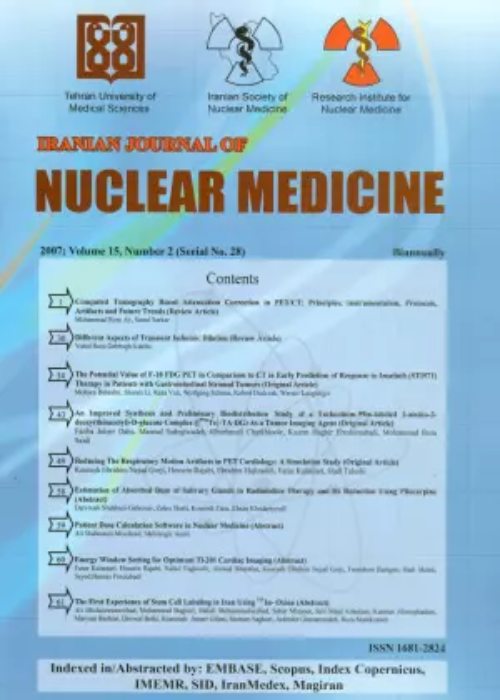Sentinel Lymph Node Biopsy in Melanoma Patients: An Experience with Tc-99m Antimony Sulfide Colloid
Author(s):
Abstract:
Introduction
Sentinel lymph node biopsy is the standard procedure for lymph node staging in intermediate thickness melanoma. In Iran, this procedure has not been addressed sufficiently. In this study, we report our experience in this area.Methods
Ten consecutive patients with intermediate thickness melanoma where included in our study. 1.5 mCi of Tc-99m antimony sulfide colloid in two divided dose was injected around the tumor. All patients underwent surgery 2-4 hours after injection of the tracer. Patent blue V dye was also used for 8 patients. Using a hand-held gamma probe, the sentinel nodes were harvested and sent to the pathologist for frozen section and H&E review. For patients with positive sentinel nodes, lymph node dissection was performed.Results
At least one sentinel node could be harvested in all patients. The mean number of sentinel nodes was 1.66. Detection rate with radiotracer and blue dye was 100% and 75% respectively. 30% of the patients had positive sentinel nodes. One patient in the pediatric age range and one head and neck melanoma were included in our study with successful sentinel node mapping.Conclusion
Sentinel lymph node biopsy using Tc-99m antimony sulfide colloid is a reliable and safe method in melanoma patients which can help in treatment planning and patient's ultimate prognosisLanguage:
English
Published:
Iranian Journal of Nuclear Medicine, Volume:18 Issue: 1, Winter-Spring 2010
Pages:
1 to 6
magiran.com/p771298
دانلود و مطالعه متن این مقاله با یکی از روشهای زیر امکان پذیر است:
اشتراک شخصی
با عضویت و پرداخت آنلاین حق اشتراک یکساله به مبلغ 1,390,000ريال میتوانید 70 عنوان مطلب دانلود کنید!
اشتراک سازمانی
به کتابخانه دانشگاه یا محل کار خود پیشنهاد کنید تا اشتراک سازمانی این پایگاه را برای دسترسی نامحدود همه کاربران به متن مطالب تهیه نمایند!
توجه!
- حق عضویت دریافتی صرف حمایت از نشریات عضو و نگهداری، تکمیل و توسعه مگیران میشود.
- پرداخت حق اشتراک و دانلود مقالات اجازه بازنشر آن در سایر رسانههای چاپی و دیجیتال را به کاربر نمیدهد.
In order to view content subscription is required
Personal subscription
Subscribe magiran.com for 70 € euros via PayPal and download 70 articles during a year.
Organization subscription
Please contact us to subscribe your university or library for unlimited access!



